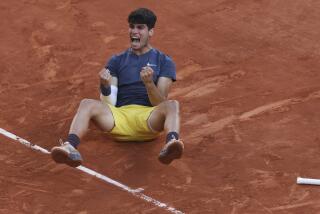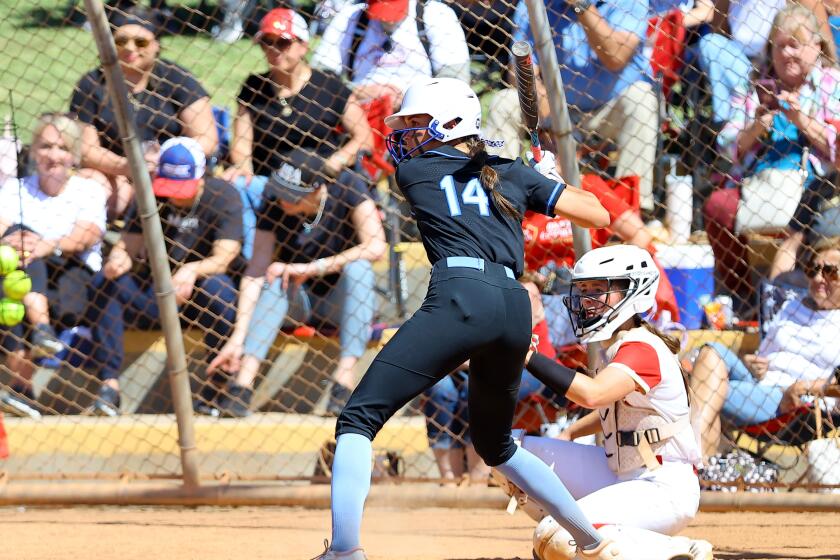Chang’s New Racket Fleecing Opponents : French Open: Soft-spoken star finds even more success by improving power, reach. Stich is latest victim.
- Share via
PARIS — Michael Chang has had it up to here with reminders of his shortcomings: He’s got no serve, in addition to being too small and not nearly strong enough to play professional tennis.
A ranking of No. 6 in the world goes a long way toward silencing critics. But people will talk. Now, he has turned to technology to gain an edge. He has adopted the policy of speaking softly and carrying a bigger stick--a longer and improved racket.
The payoff has been great. His ranking has risen two places, and Monday he reached the quarterfinals of the French Open for the first time since 1991. He waited out an hour rain delay and defeated 12th-seeded Michael Stich of Germany, 1-6, 6-0, 6-2, 6-3.
Seventh-seeded Sergi Bruguera of Spain, two-time defending champion, survived a scare from Magnus Larsson of Sweden and advanced to the quarterfinals, 6-1, 2-6, 7-5, 7-6 (7-4).
Chang’s new racket is about one inch longer than customary, at 28 inches, but well within the limit of 32 inches set by the International Tennis Federation. The longer racket gives him the opportunity to generate more power and an advantage in reach.
Chang’s serve, never highly respected, can now be considered a weapon. Monday’s match, however, was not indicative of the racket’s boost to his serve. His first serve got in only 50% of the time.
“Today is not a good example; ask me another day,” he said, laughing in response to a question about the new racket’s benefits. “Today I didn’t have a very good rhythm on my serve. Normally, it’s helped me out on my serve and my volleys. It’s probably helped me out on my ground strokes as well. I don’t think you can ever find a magical racket or anything like that.
“I’d like to think that part of it has to do with my racket and part of it has to do with spending a lot more time working on my serve. Hopefully, it’s a combination of a few things--getting a little strong in the upper body and trying to be a lot more consistent with the way I serve.”
He has long felt he was at a disadvantage because he holds his racket higher on the grip than other players, thus helping him to control it better. Holding the racket closer to the end of the handle allows a player to generate more power and whip on shots.
The new racket also has a longer grip that better accommodates Chang’s two-handed backhand.
His ground strokes were efficient against Stich, who abandoned his usual net-attacking style. Chang is always happy to play from the baseline and it proved the better choice. Stich committed 60 unforced errors to Chang’s 22.
Larsson, seeded No. 10, was the last pure serve-and-volley player left in the tournament. His serve was expected to be blunted on the slow red clay, but few expected the profusion of errors off his normally steady ground strokes.
He committed 80 unforced errors, reserving the most, 31, for the last set.
He blew most of his meaningful chances. He was serving for the third set at 5-3 and began the game by serving two double-faults. That was followed by two unforced errors.
“It was just a terrible game,” Larsson said. “And just myself to blame. Sergi didn’t have to play well--just put the balls over the net and win easily.
“When I lost the third set, I still thought I had a good chance to win, because I was feeling good. And I thought if I could make it five sets, I have a good chance to win, but I didn’t.”
Larsson’s only boost came when the crowd turned in his favor after Bruguera lost whatever sentiment he retained as the defending champion by vehemently questioning a line call in the tiebreaker.
The French crowd apparently disapproved of Bruguera’s actions, although questioning line calls during clay court matches--where the ball makes a clear mark when it lands--is common. It is equally common for the umpire to climb down from the chair and check a mark, as a courtesy to the players.
Bruguera was serving at 1-0 in the tiebreaker when Larsson hit a spectacular inside-out cross-court forehand that appeared to hit the line. The Spaniard didn’t think so. He appealed to umpire Soeren Friemel of Germany to come down and check the mark. Friemel refused, saying he had seen the ball clearly.
Bruguera again asked Friemel to check the mark, and again Friemel refused. Bruguera asked for the supervisor and said to Friemel: “You are cheating me. Default me if you want. It’s my choice not to play.”
With that, Bruguera leaned over the net, with his back to the umpire, and a stalemate ensued. After a few minutes, Larsson arrived at the net to inquire politely about the interruption. The crowd clearly thought Bruguera was out of line, whistling and booing with vigor.
Supervisor Bill Gilmour eventually arrived, and after conferring with Friemel, he told Bruguera that it was the chair umpire’s decision whether to check a mark. Case closed.
Bruguera accepted the decision and strode onto the court to serve. The crowd continued to jeer. Bruguera won the point when Larsson slammed a forehand service return into the net. That shot was Larsson’s downfall in the tiebreaker. His usually deadly forehand became an unruly, undependable stroke.
Larsson pushed a forehand long to lose the match.
Bruguera said he wasn’t sure why the crowd reacted so strongly.
“I was a little bit surprised and a little bit sad, because I like this crowd and I think I didn’t do anything wrong,” he said.
More to Read
Go beyond the scoreboard
Get the latest on L.A.'s teams in the daily Sports Report newsletter.
You may occasionally receive promotional content from the Los Angeles Times.











